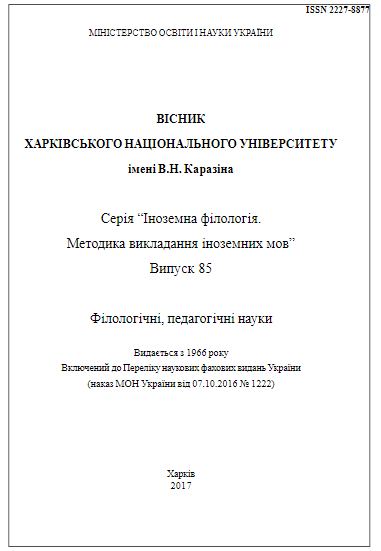Enhancement of Extramural Education by Elements of Distance Learning
Keywords:
Elements of distance education, extramural education, modern technologies, self-learning
Abstract
The article is dedicated to the paradox of increasing demand of extramural education in the 21st century and its decreasing level of training. Today the traditional extramural education is unable to ensure high effectiveness of specialists’ training. The existing potential of e-learning in modern education and the poorly developed organizational and pedagogical support of the process of preparing extramural students are flagrant.
Extramural education is still the integral part of higher education and most of its time it is devoted to student’s independent work. The aim of this work is to reveal the perspectives of development of extramural learning of foreign languages by implementing various elements of distance technologies.
Downloads
Download data is not yet available.
References
Овсянников В.И. Заочное и дистанционное образование: близнецы или антиподы? / В.И. Овсянников // Открытое образование. – 2002. – № 2. – С. 64–74.
Петров Н.В. Высшее заочное образование: проблемы и перспективы развития [Электронный ресурс] / Н.В. Петров. – Режим доступа : http://cyberleninka.ru/article/n/vysshee-zaochnoe-obrazovanie-problemy-i-perspektivy-razvitiya
Тавгень И.A. Дистанционное обучение: опыт, проблемы, перспективы / И.A. Тавгень; под ред. Ю.В. Позняка. – [2-е изд., исправл. и доп.]. – Минск : БГУ, 2003. – 227 с.
Хусаинова Е.Н. Методика обучения и организация самообучения английскому языку на заочном отделении неязыковых вузов [Электронный ресурс] / Е.Н. Хусаинова. – Режим доступа : http://vestnik.stavsu.ru/54-2008/09.pdf
Abel R. Implementing the Best Practices in Online Learning / R.Abel // EDUCAUSE Quarterly. – #28(3). – 2005. – S. 75–77.
Aspin D.N. Second International Handbook of lifelong learning / Aspin D.N.,
Chapman J.D., Evans K., Bagnall R.G. // Springer International handbooks of education. – P. 1. – London, NewYork : Introduction, 2012. – P.45–46.
Boezerooy P. Models of Technology and Change in Higher Education / Boezerooy P., Collis, B., Van Der Wende // International Comparative Survey on the Current and Future Uses of ICT in Higher Education : Paper presented at 24th Annual EAIR Forum. – Prague, 2002.
Chickering A.W. Implementing the Seven Principles: Technology as Lever 9 [Electronic resource] / Chickering A.W., Ehrmann S.C. // AAHE Bulletin, #49(2). – 1996. – S. 3–6. – Access mode : http://sphweb. bumc.bu.edu/otlt/teachingLibrary/Technology/seven_ principles.pdf
Donohue B. Faculty and Administrators Collaborating for E-Learning Courseware 9 [Electronic resource] / Donohue B., Howe-Steiger L. // Educause Quarterly, 28 (1). – 2005. – S. 20–32. – Access mode : http://er.educause.edu/articles/2005/1/faculty-and-administrators-collaborating-for-elearning-courseware
Guri-Rosenblit S. Digital technologies in higher education: Sweeping expectations and actual effects / S. Guri-Rosenblit. – New York : Nova Science Publishers, Inc., 2009. – P. 25–26.
Кeegan D.A. Typology of distant learning systems / D.A. Кeegan // Distance Education: new perspectives / Ed. by K. Harry. – New York : Routledge, 1993 – P. 63.
McQuerrey L. Why Is Teamwork Important in the Classroom? [Electronic resource] / L. McQuerrey. – Access mode : http://work.chron.com/teamwork-important-classroom- 18281.html
Reynolds L. Giving Student Feedback: 20 Tips To Do It Right [Electronic resource] / L. Reynolds. – Access mode : http://www.opencolleges. edu.au/informed/features/giving-student-feedback/
Trucano M. Knowledge Maps: Icts in Education / M. Trucano // Infodev. World Bank: The Information for Development Program. – Washington D.C., 2005. – P. 35–38.
Петров Н.В. Высшее заочное образование: проблемы и перспективы развития [Электронный ресурс] / Н.В. Петров. – Режим доступа : http://cyberleninka.ru/article/n/vysshee-zaochnoe-obrazovanie-problemy-i-perspektivy-razvitiya
Тавгень И.A. Дистанционное обучение: опыт, проблемы, перспективы / И.A. Тавгень; под ред. Ю.В. Позняка. – [2-е изд., исправл. и доп.]. – Минск : БГУ, 2003. – 227 с.
Хусаинова Е.Н. Методика обучения и организация самообучения английскому языку на заочном отделении неязыковых вузов [Электронный ресурс] / Е.Н. Хусаинова. – Режим доступа : http://vestnik.stavsu.ru/54-2008/09.pdf
Abel R. Implementing the Best Practices in Online Learning / R.Abel // EDUCAUSE Quarterly. – #28(3). – 2005. – S. 75–77.
Aspin D.N. Second International Handbook of lifelong learning / Aspin D.N.,
Chapman J.D., Evans K., Bagnall R.G. // Springer International handbooks of education. – P. 1. – London, NewYork : Introduction, 2012. – P.45–46.
Boezerooy P. Models of Technology and Change in Higher Education / Boezerooy P., Collis, B., Van Der Wende // International Comparative Survey on the Current and Future Uses of ICT in Higher Education : Paper presented at 24th Annual EAIR Forum. – Prague, 2002.
Chickering A.W. Implementing the Seven Principles: Technology as Lever 9 [Electronic resource] / Chickering A.W., Ehrmann S.C. // AAHE Bulletin, #49(2). – 1996. – S. 3–6. – Access mode : http://sphweb. bumc.bu.edu/otlt/teachingLibrary/Technology/seven_ principles.pdf
Donohue B. Faculty and Administrators Collaborating for E-Learning Courseware 9 [Electronic resource] / Donohue B., Howe-Steiger L. // Educause Quarterly, 28 (1). – 2005. – S. 20–32. – Access mode : http://er.educause.edu/articles/2005/1/faculty-and-administrators-collaborating-for-elearning-courseware
Guri-Rosenblit S. Digital technologies in higher education: Sweeping expectations and actual effects / S. Guri-Rosenblit. – New York : Nova Science Publishers, Inc., 2009. – P. 25–26.
Кeegan D.A. Typology of distant learning systems / D.A. Кeegan // Distance Education: new perspectives / Ed. by K. Harry. – New York : Routledge, 1993 – P. 63.
McQuerrey L. Why Is Teamwork Important in the Classroom? [Electronic resource] / L. McQuerrey. – Access mode : http://work.chron.com/teamwork-important-classroom- 18281.html
Reynolds L. Giving Student Feedback: 20 Tips To Do It Right [Electronic resource] / L. Reynolds. – Access mode : http://www.opencolleges. edu.au/informed/features/giving-student-feedback/
Trucano M. Knowledge Maps: Icts in Education / M. Trucano // Infodev. World Bank: The Information for Development Program. – Washington D.C., 2005. – P. 35–38.
Published
2017-10-29
How to Cite
Galstyan, A. (2017). Enhancement of Extramural Education by Elements of Distance Learning. The Journal of V.N. Karazin Kharkiv National University. Series: Foreign Philology. Methods of Foreign Language Teaching, (85), 187-195. https://doi.org/10.26565/2227-8877-2017-85-28




